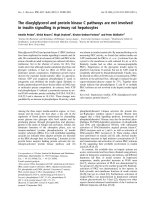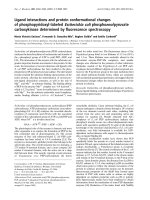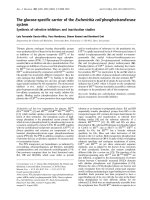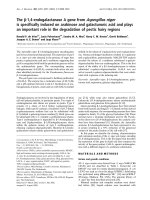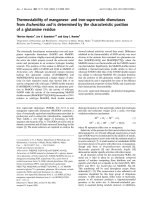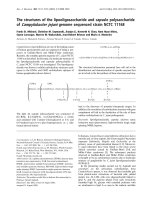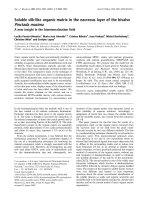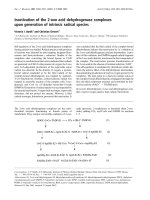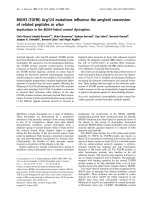Tài liệu Báo cáo Y học: The Ikaros family protein Eos associates with C-terminal-binding protein corepressors pptx
Bạn đang xem bản rút gọn của tài liệu. Xem và tải ngay bản đầy đủ của tài liệu tại đây (198.33 KB, 8 trang )
The Ikaros family protein Eos associates with C-terminal-binding
protein corepressors
Jose
´
Perdomo and Merlin Crossley
Department of Biochemistry, G08, University of Sydney, NSW, Australia
Eos is a zinc finger transcription factor of the Ikaros family.
It binds typical GGGAA Ikaros recognition sites in DNA
and functions as a transcriptional repressor. Here we show
that Eos associates with the corepressor C-terminal-binding
protein (CtBP). CtBP has previously been shown to bind
Pro-X-Asp-Leu-Ser (PXDLS) motifs in several DNA-
binding proteins. We note that Eos contains a related motif
PEDLA, and we demonstrate that CtBP can bind this site
weakly but that it also contacts additional regions of Eos.
Consistent with this finding, mutation of the PEDLA motif
does not negate CtBP binding or CtBP-mediated repression
by Eos. CtBP has previously been shown to bind to a
PXDLS-type motif in Ikaros, and we show that another
Ikaros-related protein TRPS1 also contains a PXDLS CtBP
contact motif within its repression domain. We conclude
that several Ikaros family proteins utilize CtBP corepressors
to inhibit gene expression.
Keywords: corepressors; gene regulation; Ikaros; repression;
transcription.
The zinc finger transcription factor Ikaros was originally
identified as a DNA-binding protein that recognized a
critical regulatory region of the T cell-restricted CD3d gene
[1]. Ikaros expression is confined to erythroid and myeloid
precursors in the early stages of differentiation and to the
lymphoid compartment in the adult [2,3]. The Ikaros gene
codes for a protein with six zinc fingers that comply with the
Kru
¨
ppel C2-H2 consensus. The N-terminal fingers are
involved in sequence-specific DNA binding [4], while the
two zinc fingers that form the C-terminal domain mediate
homodimerization [5]. Alternative mRNA splicing gener-
ates at least eight isoforms (Ik-1 to Ik-8) containing subsets
of the N-terminal fingers and all sharing the C-terminal
domain. Isoforms containing at least three N-terminal
fingers are able to bind to the Ikaros consensus recognition
sequence [4].
The subsequent cloning of Aiolos and Helios [6–8], and of
Eos and Pegasus [9], revealed the existence of a family of
related factors. Ikaros, Aiolos and Helios are all abundantly
expressed in the haematopoietic system and are all known
or predicted to have roles in lymphoid development,
whereas Eos and Pegasus are more broadly expressed, as
mRNA is detected in several human tissues [9]. Recently a
more distantly related member of the Ikaros family, the
tricho-rhino-phalangeal syndrome protein TRPS1, has been
described [10,11]. This protein contains the characteristic
C-terminal domain consisting of two zinc fingers capable
of mediating dimerization, but also contains additional
Kru
¨
ppel-like zinc fingers and one GATA-type finger.
Figure 1 shows schematic representations of Ikaros, Eos
and TRPS1.
Studies of murine knockouts have revealed that Ikaros is
essential for the regulation of commitment of haematopoi-
etic stem cells to the lymphoid lineage. In Ikaros null mice
(Ik
–/–
), B cells and their precursors are absent, and T cells
are undetected in the fetus but develop (abnormally) post
partum [12]. Mice expressing an Ikaros protein that lacks
the DNA-binding domain (dominant negative DN
–/–
mutation) display more extreme effects, with a complete
absence of T cells and death from severe infections soon
after birth [2]. The severity of the DN
–/–
mutation suggests
that this aberrant Ikaros protein, which cannot bind DNA,
is still able to dimerize with other Ikaros family proteins
and, most likely, interfere with their functions. Aiolos
–/–
mice show expanded B cell populations and autoimmunity,
but are normal in their thymic and splenic T cell develop-
ment [13], a phenotype consistent with the predominant
expression of Aiolos in B cells. No knockouts have been
reported for the other family members.
The molecular mechanisms by which members of the
Ikaros family recognize DNA and regulate gene expression
are under intense investigation [14–18]. Ikaros, Aiolos,
Helios and Eos all recognize the consensus Ikaros-binding
site GGGAA in vitro and in cellular assays, whereas Pegasus
recognizes a distinct binding sequence GNNTGTNG [9].
TRPS1, by virtue of its GATA-type zinc finger, can
recognize GATA sites in DNA but may also bind to
additional elements through its Kru
¨
ppel-like fingers. In
transient assays, all these proteins are able to modestly
influence the transcription of reporter genes driven by their
cognate sites [4,8,9]. Aiolos and Helios have been reported
to function as activators, Ikaros has been implicated in both
activation and repression, and Eos, Pegasus and TRPS1
have so far only been implicated in transcriptional repres-
sion. Recently attention has focused on the role of Ikaros as
a repressor, and interactions have been reported with Sin3
[19] and Mi-2 [20], which are components of deacetylase and
chromatin remodelling complexes.
Correspondence to M. Crossley, Department of Biochemistry,
G08, University of Sydney, NSW, Australia, 2006.
Fax: 61 29351 4726, Tel.: 61 29351 2233,
E-mail:
Abbreviations: TRPS1, tricho-rhino-phalangeal syndrome protein;
CtBP, C-terminal-binding protein; GST, glutathione S-transferase.
(Received 8 August 2002, revised 19 September 2002,
accepted 15 October 2002)
Eur. J. Biochem. 269, 5885–5892 (2002) Ó FEBS 2002 doi:10.1046/j.1432-1033.2002.03313.x
Ikaros has also been shown to bind coregulatory proteins
of the C-terminal-binding protein (CtBP) family (reviewed
in [21]). CtBP was named after it was first purified as a
protein that bound to the C-terminus of the Adenovirus
E1A protein [22]. CtBPs have been identified in Caenor-
habditis, Drosophila, and mammals, and data from
Drosophila and mammals have shown that CtBPs can
function as transcriptional corepressors in vivo.CtBP
recognizes PXDLS motifs found in the repression domains
of a wide range of transcription factors. Identified partners
include Drosophila Hairy, Snail and Kru
¨
ppel [23,24],
BKLF/KLF3 [25], FOG [26], KLF8 [27] and Ikaros [15].
There are two highly homologous mammalian CtBP family
members, CtBP1 and CtBP2, encoded by separate genes,
but, to date, no differences in the activity of these two
proteins have been reported. In this study, we used murine
CtBP2 [25], but it is likely that the results will also apply to
CtBP1, and therefore, in some instances, we use the term
CtBP for simplicity.
CtBP has been shown to associate with Ikaros through
a PEDLS motif in its N-terminus (Fig. 1A,B) [15]. As
Ikaros makes multiple contacts with coregulatory proteins,
experiments with full-length Ikaros can be difficult to
interpret but, by studying the N-terminal repression
domain in isolation, Koipally & Georgopoulos [15] were
able to show that CtBP contact was required for the
repression activity of this domain. This repression activity
is histone deacetylase independent, and the precise mech-
anism of repression remains unknown. Here, we show that
Eos also interacts with CtBP to repress transcription.
CtBP recognizes a PEDLA motif in the C-terminus of
Eos, but the interaction does not completely depend on
this motif, suggesting that the Eos–CtBP interaction
involves multiple surfaces. Consistent with this result, we
demonstrate that CtBP recognizes several regions within
Eos. In addition, we show that CtBP can bind a PXDLS
motif in a previously well-characterized C-terminal repres-
sion domain in the TRPS1 protein [11], and we suggest
that a CtBP-mediated mechanism may be common in
Ikaros-like proteins.
EXPERIMENTAL PROCEDURES
Plasmids
Bait plasmids used in the yeast two-hybrid experiments were
generated by fusing the desired regions downstream and
in-frame of the Gal4 DNA-binding domain of the yeast
expression vector pGBT9 (Clontech). All numbers indicated
refer to amino acids in the respective sequences. The bait
plasmids were pGBT9.Eos364–400, pGBT9.Eos364–
400.mut, pGBT9.Eos364–400DEtoIk (Eos
372
PED-
LADGG
379
changed to Ikaros site PEDLSTTS),
pGBT9.TRPS1210-1281, and pGBT9.mCtBP2 [25]. Prey
plasmids were constructed by inserting the desired sequences
in-frame and downstream of the Gal4 activation domain of
the pGAD10 vector (Clontech). Full-length vectors are
pGAD10.Eos and pGAD10.mCtBP2, pGAD10.Pegasus
and pGAD10.Ikaros2. Other plasmids are pGA-
D10.Eos101–531, pGAD10.Eos101–531.mut, pGAD10.
Eos101–364, pGAD10.Eos101–331, pGAD10.Eos101–
231, pGAD10.Eos364–518, pGAD10.Eos364–518.mut,
pGAD10.Ikaros1–81, pGAD10.Ikaros1–81.mut, pGA
D10.TRPS1068–1186, pGAD10.TRPS1068–1186.mut,
pGAD10.TRPS1210–1281 and pGAD10.Aiolos447–507.
Expression vectors for mammalian systems used were
constructed in the parental plasmids pcDNA3 (Invitrogen)
and pMT2. The vectors include pcDNA3. Gal4DBD,
pcDNA3.mCtBP2 [25], pcDNA3.Eos, pcDNA3.Gal4-
DBD.Eos364–518, pcDNA3.Gal4DBD.Eos364–518.mut,
pcDNA3.Gal4DBD.Ikaros1–81, pcDNA3.Gal4DBD
Ikaros1–81.mut, pcDNA3.Gal4DBD.TRPS1068–1281,
pcDNA3.Gal4DBD.TRPS1068–1281.mut, pMT2.mCTBP2,
pMT2.FLAG.Eos, pMT2.FLAG.Eos.mut, pMT2.FLA-
G.Eos101–389, pMT2.FLAG.Eos101–331, and pMT2.
FLAG.Eos101–231. Glutathione S-transferase (GST) fu-
sion mCtBP2 protein was produced by inserting mCtBP2
cDNA in-frame with GST in the pGEX-2T vector (Amer-
sham Pharmacia Biotech) [25]. The luciferase reporter
vector contained five copies of the Gal4 DNA-binding
domain upstream of the TK promoter in the vector pGL2-
TK (Promega).
Yeast two-hybrid and pull-down assays
The Clontech yeast two-hybrid system was used according
to the manufacturer’s instructions. The prey and bait
plasmids used are described above. Recombinant GST-
mCtBP2 was produced in Escherichia coli strain BL-21,
purified as described [28] and immobilized on glutathione
beads.
35
S-labelled Eos and Eos.mut production and the
pull-down experiments were carried out as described [9].
Ikaros MPVPEDLSTTS
31 41
Eos GEGPEDLADGG
369 379
TRPS1 NDIPLDLAIKH
1160 1170
A
B
Ikaros
Eos
TRPS1
DNA binding Dimerization
517
532
1281
Dimerization
GATA finger
PXDLS motif
Intron/Exon boundary
Fig. 1. Schematic representation of Ikaros, Eos and TRPS1. (A)
Diagram of Ikaros, Eos and TRPS1. The zinc fingers are represented
by unfilled semi-ellipses, the positions of the PXDLS-like motif are
indicated by filled rectangles, and the intron/exon boundaries by
arrows. Amino-acid numbers are indicated in each case. For Ikaros
and Eos, the N-terminal fingers involved in sequence-specific DNA
recognition are shown, and the GATA-type finger required for
binding of TRPS1 to GATA sites is shown. The C-terminal fingers
that are characteristic of the Ikaros family and mediate dimerization
are also indicated. (B) The sequences corresponding to the PXDLS-
like motif for the three proteins in (A) are shown. Amino-acid
numbers are indicated.
5886 J. Perdomo and M. Crossley (Eur. J. Biochem. 269) Ó FEBS 2002
In vitro
transcription and translation
In vitro transcription and translation of proteins has been
described [9].
Western blot and immunoprecipitation
Transfected COS cells were washed with cold NaCl/P
i
and
resuspended in 400 lL cold solution A (10 m
M
Hepes,
pH 7.8, 1.5 m
M
MgCl
2
,10m
M
KCl) supplemented before
use with 1 m
M
dithiothreitol, 50 ngÆmL
)1
phenyl-
methanesulfonyl fluoride, 5 lgÆmL
)1
leupeptin and
5 lgÆmL
)1
aprotinin. The tubes were incubated on ice for
10 min, vortex-mixed for 10 s, and centrifuged for 10 s at
12 000 g to pellet the nuclei. The nuclei were resuspended in
30–50 lL solution C (20 m
M
Hepes, pH 7.8, 25% glycerol,
420 m
M
NaCl, 1.5 m
M
MgCl
2
,0.2m
M
EDTA) supplemen-
ted as above, centrifuged for 3 min at 14 000 r.p.m. at 4 °C.
The extracts were used immediately or stored at )70 °C.
Proteins were separated by SDS/PAGE on 8–10%
polyacrylamide gels and transferred on to a Biotrace
TM
nitrocellulose blotting membrane (Pall Gelman Sciences,
Ann Arbor, MI, USA) in a TE series Transphor
TM
electrophoresis unit (Hoefer), at 50 mA overnight at 4 °C.
For Western blotting, the membrane was washed once in
50 m
M
Tris/HCl, pH 7.5, containing 150 m
M
NaCl and
0.05% Tween-20 (Tris/NaCl/Tween), then incubated at
room temperature in skimmed milk powder solution
[5% (w/v) in Tris/NaCl/Tween] for 1 h. The membrane
was rinsed in Tris/NaCl/Tween and incubated for 1 h with
gentle shaking in 10 mL Tris/NaCl/Tween containing 10 lg
primary antibody. After a wash with 4 · 100 mL Tris/
NaCl/Tween, the secondary antibody solution was added
and incubation was continued for 1 h. The membrane was
washed for 1 h in several changes of Tris/NaCl/Tween.
Detection was carried out using the RenaissanceÒ Chemi-
luminescence reagent plus (NEN Life Sciences, Boston,
MA, USA), and the signal detected on X-ray film (Eastman
Kodak Company, Rochester, NY, USA) and developed
using Kodak reagents.
Covalently linked protein A/G-agarose beads (Boehrin-
ger, Mannheim, Germany) and the antibody of interest
were prepared as follows. The beads plus antibody were
incubated for 1 h at room temperature in 1 mL NaCl/P
i
at
2 lg antibody/lL wet beads. The bead–antibody complex
was washed twice with 10 vol. 0.2
M
sodium borate, pH 9.0,
and the beads were resuspended in 10 vol. 0.2
M
sodium
borate, pH 9.0. Solid dimethyl pimelimidate (Sigma) was
added to a final concentration of 20 m
M
, incubated for
30 min at room temperature, and the reaction stopped by
washing once in 10 vol. 0.2
M
ethanolamine, pH 8.0, and
then incubating for 2 h at room temperature in 10 vol.
0.2
M
ethanolamine, pH 8.0. Coupled beads were resus-
pended in 1 vol. NaCl/P
i
andstoredat4°C.
For immunoprecipitations, nuclear extracts were diluted
1 : 3 in Nonidet P40 buffer (50 m
M
Tris/HCl, pH 7.4,
150 m
M
NaCl, 0.5–1.0% Nonidet P40, 1 lgÆmL
)1
leupep-
tin, 1 lgÆmL
)1
aprotinin, 1 m
M
phenylmethanesulfonyl
fluoride). Lysates were precleared with 20 lLproteinA/G
beads for 30 min at 4 °C. The cleared lysates were treated
with 5–15 lL beads–antibody complex for 1 h at 4 °C with
rocking. The beads were pelleted at 14 000 r.p.m. for 10 s,
the supernatant discarded, and the beads washed (4 · 1mL
cold Nonidet P40 buffer). The proteins retained on the
beads were separated by SDS/PAGE and detected by
Western blotting.
Transfections and luciferase assay
NIH-3T3 cells were transfected with 3 lg of the reporter
pGL2(Gal4)
5
TK and different amounts (0.5–2 lg) of
pcDNA3.Gal4DBD, pcDNA3.mCtBP2, pcDNA3.Gal4
DBD.Eos364–518, pcDNA3.Gal4DBD.Eos364–518.mut,
pcDNA3.Gal4DBD.Ikaros1–81, pcDNA3.Gal4DBD
Ikaros1–81.mut, pcDNA3.Gal4DBD.TRPS1068–1281
and pcDNA3.Gal4DBD.TRPS1068–1281.mut using the
calcium phosphate method [29]. Luciferase activity was
measured as described [9]. COS cells were transfected with
2 lg pMT2, pMT2.mCTBP2, pMT2.FLAG.Eos, pMT2.
FLAG.Eos.mut, pMT2.FLAG.Eos101–389, pMT2.FLAG.
Eos101–331 and pMT2.FLAG.Eos101–231 by the DAE-
Dextran method [29], and harvested 48–60 h after transfec-
tion. The total amount of transfected DNA was kept
constant in all cases by addition of ÔnakedÕ pcDNA3 or
pMT2 vectors, as appropriate.
RESULTS
Eos interacts with CtBP
in vitro
and
in vivo
The observation that Eos can function to repress gene
expression [9] prompted us to investigate whether it
associated with recognized corepressor proteins. We noted
that the C-terminal region of Eos contains a sequence,
372
PEDLA
376
, that resembles the accepted consensus CtBP-
binding motif PXDLS [21]. The Eos motif differs from the
consensus at the final residue, but a previously identified
partner, Enhancer of Split md, also has alanine at the fifth
position, suggesting that this change would not preclude
CtBP binding [23]. We first tested the ability of in vitro
transcribed and translated Eos protein to interact with
bacterially expressed and purified GST–CtBP. Figure 2A
shows that GST–CtBP but not GST alone is able to retain
35
S-Eos. The Eos–CtBP contact was also confirmed using
the yeast two-hybrid system. We cotransformed yeast with
vectors encoding a Gal4 activation domain–Eos fusion,
and a Gal4 DNA-binding domain–CtBP fusion and
observed activation of the HIS3 reporter gene as indicated
by yeast growth in the absence of histidine (Fig. 2B).
Finally, we assessed the interaction using coimmunopre-
cipitation experiments. COS cells were transfected with
vectors expressing FLAG-tagged Eos and native CtBP.
FLAG-Eos was recovered by immunoprecipitation with a
FLAG antibody, and the presence of CtBP assessed by
Western blotting using anti-CtBP serum. As shown in
Fig. 2C, CtBP was present in the recovered material.
Taken together these results indicate that Eos and CtBP
physically interact.
The PEDLA motif of Eos is not the sole determinant
of the CtBP interaction
In most instances, such as the case of Ikaros [15], deletion or
mutation of a single critical PXDLS motif results in
abrogation of CtBP contact and functional consequences
of CtBP association. We examined whether the binding of
Ó FEBS 2002 Eos binds the corepressor CtBP (Eur. J. Biochem. 269) 5887
CtBP to Eos required the PEDLA motif by mutating this
motif to AAALA (Eos-mut). Interestingly, we found that
this mutation did not eliminate the Eos–CtBP interaction.
Figure 2D shows that GST–CtBP is also able to retain
radiolabelled Eos-mut. Figure 2E shows that yeast har-
bouring an expression vector encoding a Gal4 activation
domain–Eos-mut fusion and a Gal4 DNA-binding
domain–CtBP fusion grow in the absence of histidine, and
Fig. 2F indicates that CtBP can be immunoprecipitated
with FLAG-tagged Eos-mut. These results suggest that
CtBP does not depend exclusively on the Eos PEDLA motif
for interaction and may make additional contacts through
other domains within the Eos protein.
There are several precedents for CtBPs contacting
partners through regions outside recognizable PXDLS
motifs [30–32]. To delineate additional Eos domains
involved in CtBP recruitment, a series of deletion mutants
was constructed (Fig. 3A). The CtBP-interacting properties
of these mutants were tested using the yeast two-hybrid
system. As seen in Fig. 3A, CtBP was able to associate with
both the N-terminal and C-terminal domains of Eos. To
determine whether the
372
PEDLA
376
motif in the
C-terminus was primarily responsible for binding to this
domain, we again mutated this motif to AAALA, but this
time in the context of the C-terminal domain Eos364–518.
Again mutation of the motif did not significantly affect
CtBP binding. We carried out the same experiment in the
context of a minimal Eos domain, Eos364–400 and found
that this region still bound CtBP. In this construct, however,
the PEDLA to AAALA mutation reduced binding. We also
made a second mutant replacing the nontypical PEDLA
motif of Eos with the recognized PEDLS motif of Ikaros
and observed a stronger interaction (Fig. 3A). Taken
together these results suggest that the PEDLA motif in
Eos is suboptimal and not the major determinant of CtBP
binding, but that it and other sites within the N-terminus
and C-terminus of Eos contribute to CtBP contact.
We also confirmed the presence of the N-terminal
CtBP-binding domain using coimmunoprecipitation
experiments. The FLAG-tagged Eos constructs shown in
Fig. 3B were cotransfected with CtBP into COS cells, and
immunoprecipitation experiments were carried out.
Figure 3C is a Western blot showing that all three Eos
constructs are expressed at comparable levels. Figure 3D
shows an immunoprecipitation experiment with FLAG
antisera or an irrelevant antibody in the mock lane.
Western blotting with a CtBP antiserum shows that CtBP
is associated with the immunoprecipitated material in all
cases in which the FLAG antiserum was used, although
most CtBP was retained by the longest construct. The
results were confirmed by the reciprocal experiment,
immunoprecipitating with CtBP antiserum and analyzing
the material by Western blotting with anti-FLAG serum
(Fig. 3E). As can be seen, the three Eos deletion constructs
are detected in the material immunoprecipitated by the
anti-CtBP serum, and again the longest construct appears
to have been retained more efficiently. No Eos fragments
were detected when an irrelevant antibody was used in a
similar experiment (data not shown). These findings
confirm the observation that, in addition to binding the
Fig. 2. Eos interacts with CtBP. (A) Purified
GST and GST–CtPB were used to assess the
interacting activities of in vitro transcribed and
translated Eos protein. GST–CtBP but not
GST alone retained radiolabelled Eos protein.
(B) The interaction was confirmed using the
yeast two-hybrid system. Plasmids present in
the various yeast derivatives are shown.
Growth on this plate lacking histidine, leucine
and tryptophan is indicative of a positive
interaction. (C) FLAG-tagged Eos and CtBP
werecotransfectedintoCOScellsandnuclear
extracts used for immunoprecipitations. Lane
1 (input) indicates the migration of CtBP in
the extracts, control mock transfected cells
(lane 2) and detected (lane 3) CtBP after
immunoprecipitation with anti-FLAG serum.
IP, Immunoprecipitation. (D) Purified GST
and GST–CtPB were used to assess the inter-
acting activities of in vitro transcribed and
translated Eos.mut protein. GST–CtBP
retained radiolabelled mutant os protein. (E)
and (F), as for (B) and (C). Mutant Eos was
tested in both cases. IP, Immunoprecipitation.
5888 J. Perdomo and M. Crossley (Eur. J. Biochem. 269) Ó FEBS 2002
C-terminal domain of Eos, CtBP can also bind sites within
the N-terminal domain of Eos.
TRPS1 interacts with CtBP
The TRPS1 protein is a multi-(zinc finger) protein that
contains two C-terminal fingers highly related to the Ikaros
family dimerization domain [10,11]. Little is known of the
molecular roles of TRPS1 or its target genes. It is known
that TRPS1 is capable of binding typical GATA sites via its
GATA-type zinc finger and that TRPS1 can act to repress
the expression of GATA-dependent reporter genes [11]. The
relevant repression domain has been localized to the
C-terminal 119 residues of the protein [11]. We noted that
this minimal repression domain contains a potential CtBP
contact motif,
1163
PLDLA
1167
. This observation implied
that the repression domain might function by recruiting the
corepressor CtBP.
As the yeast two-hybrid system has proved a very reliable
indicator of CtBP contact in all instances previously
reported [21], we used this assay to determine whether the
repression domain of TRPS1 was capable of interacting
with CtBP. We found that there was a strong interaction in
yeast (Fig. 4A,B). The amount of yeast growth was
comparable to that observed for the isolated CtBP-binding
region of Ikaros (Fig. 4A,B, construct 1). Mutation of the
putative CtBP-binding motif
1163
PLDLA
1167
to ALAAA
abolished the interaction (Fig. 4A, construct 4), suggesting
that it was the major determinant of CtBP binding within
the repression domain.
CtBP-interacting regions of Eos, Ikaros and TRPS1
function as CtBP-dependent repression domains
Deletion analysis of Ikaros has indicated that it contains
distinct domains that are implicated in activating or
repressing transcription [4,5,19,33]. One discrete domain
within the N-terminus contains the motif PEDLS and has
been shown to contact CtBP and function as a CtBP-
dependent repression domain. We investigated whether the
PXDLS regions of Eos and TRPS1 also functioned as
CtBP-dependent repression domains. The regions were
tested as Gal4 DNA-binding domain fusions for their
ability to repress transcription in transient transfection
experiments in mammalian cells. Gal4Ikaros1–81,
Gal4Eos364–518, and Gal4TRPS1068–1281 were transfect-
ed individually into NIH-3T3 cells and tested against a
luciferase reporter gene driven by five Gal4-binding sites
upstream of the TK promoter. Figure 5A shows that
Gal4Ikaros1–81 represses the transcription of the reporter
gene. A mutation in the PEDLS motif abolished the ability
of this domain to repress transcription, consistent with
previous findings that these residues are required for CtBP
recruitment and repression. We also observed that when
submaximal amounts of the Ikaros construct (0.1 lg) were
Fig. 3. Eos deletion constructs interact with CtBP in yeast and in COS
cells. (A) Schematic representation of Eos constructs tested against
CtBP in the yeast two-hybrid system. Numbers indicate the amino
acids in the Eos sequence, the filled rectangle indicates the position of
the PEDLA motif, and the cross represents mutation of this motif.
(Rectangle) Ik indicates mutation to resemble the Ikaros motif PED-
LSTT.(+)growthobserved;(–)nogrowth.Forcomparison,the
CtBP-interacting region of Ikaros (Ikaros1–81) is also shown. Yeast
growth on plates lacking histidine is shown for selected constructs.
These plates represent growth after 4 days of 10 lL of undiluted,
1 : 10 and 1 : 100 dilutions of D
600
solutions. (B) Schematic repre-
sentation of FLAG-tagged Eos constructs used for immunoprecipi-
tations. Numbers indicate the amino acids in the Eos sequence. (C)
Western blot of the Eos constructs in (B) expressed in COS cells. (D)
Immunoprecipitation showing that the three Eos N-terminal con-
structs are able to associate with cotransfected CtBP, lanes 1–3. (E)
The reciprocal experiment with anti-CtBP serum precipitating the
cotransfected Eos constructs (arrows) shown in (B) and (C). The
prominent bands seen above the bands of interest (arrowheads) cor-
respond to the heavy chain of the antibodies used because of incom-
plete covalent coupling of the antibodies to the agarose beads. IP,
Immunoprecipitation.
Fig. 4. TRPS1 and Ikaros interact with CtBP through their PXDLS-
like motifs. (A) Schematic representation of the fragments tested.
Numbers indicate the amino acids of the respective protein. Filled
rectangles indicate the position of the PXDLS-like motif, and the cross
represents mutation of this motif. (B) Yeast growth in the absence of
histidine is indicative of a positive interaction.
Ó FEBS 2002 Eos binds the corepressor CtBP (Eur. J. Biochem. 269) 5889
used, cotransfection with a CtBP expression vector (0.5 lg)
potentiated repression. These results corroborate previous
observations on CtBP-dependent repression by this Ikaros
domain [15]. Figure 5B shows a similar experiment on the
PEDLA motif-containing domain of Eos. This domain also
functions to repress the reporter, but mutation of the
PEDLA motif does not abrogate repression. This result is
consistent with the protein interaction data showing that
this mutation does not prevent contact with CtBP. Again,
when low amounts of the Eos construct (0.1 lg) were used,
addition of a CtBP expression vector (0.5 lg) potentiated
repression, confirming the result that Eos364–518 depends
on CtBP, although the PEDLA motif is not essential for its
recruitment. Finally, Fig. 5C shows results with the TRPS1
PLDLA-containing domain. This portion of the protein
functioned as a potent repression domain and mutation of
the PLDLA motif abrogated repression activity, consistent
with the protein interaction result that this motif was
required for CtBP contact. Again addition of a CtBP
expression vector potentiated repression when low amounts
of the TRPS1 construct were tested. Overall these results
indicate that these three Ikaros family proteins all contain
repression domains that are dependent on CtBP.
DISCUSSION
CtBP has previously been shown to bind to repression
domains in a number of transcription factors and other
regulatory proteins [21]. The results reported here show
that CtBP binds repression domains within three mem-
bers of the Ikaros family of transcription factors. In each
case, the domains contain a recognizable PXDLS-type
motif but the PEDLA motif in Eos is not the sole
determinant of CtBP contact. Furthermore the PEDLA
motif in Eos appears to be a relatively weak binding site,
as its replacement with the well-characterized PEDLS
motif of Ikaros substantially increased the association
with CtBP. Although the PEDLA motif in Eos supports
only weak binding of CtBP, we show that additional
regions within the N-terminal and C-terminal regions of
Eos also contact CtBP, and, taken together, the results of
GST-pulldown, yeast two-hybrid and immunoprecipita-
tion experiments demonstrate that Eos and CtBP can
stably associate.
Although PXDLS motifs have often been shown to be
the primary determinant of CtBP binding, there are other
examples where they are not essential for corepressor
contact, and there are even cases where CtBP partner
proteins contain no recognizable PXDLS motif. The zinc
finger protein Tramtrack69 contains a PPDLS motif, but
this is not required for binding [31], and HDAC5 contains
arelatedmotif(PVELR)thatisdispensableforCtBP
contact [32]. In the case of HDAC1, no canonical CtBP
recognition sequences have been found [30]. We presume
that generally the PXDLS motif on the DNA-binding
protein slots into a putative PXDLS-accepting pocket
within CtBP. In the cases where the PXDLS motif is not
required for binding and other contacts are made, we
expect that other (nonpocket) regions of CtBP will be
involved in the interaction. In this way, it seems likely that
proteins such as Eos may be able to bind to CtBP that is
already associated with another PXDLS motif-containing
protein. For instance, Eos may bind to a CtBP molecule,
the pocket of which is already complexed to Ikaros.
Indeed, we have previously shown that the conserved
C-terminal dimerization domain of Eos can associate with
the related domain in Ikaros [9], so Eos may in fact be able
to bind Ikaros and CtBP to form a trimeric complex. We
have also tested the association of Eos with other Ikaros
family members and shown that it can bind the dimeriza-
tion domain of TRPS1 (unpublished results), raising the
possibility that Eos may also function in a similar manner
in a complex with TRPS1 and CtBP.
There is good evidence that Ikaros proteins dimerize [5]
and possibly form higher-order multimers in vivo [7,16], but
the precise mechanisms by which various Ikaros-containing
complexes operate remains under investigation. In addition
to binding CtBP, Ikaros has been found in T cells as part of
two discrete histone deacetylase complexes by virtue of its
interaction with the ATPase Mi-2 [20] and the corepressor
X
1
81
Eos
Gal4DBD
Ikaros
Gal4DBD
0.5µg
0.1µg
1.0µg
0.1µg
1.0µg
0.5µg
0.1µg
1.0µg
1.0µg
X
1068
1281
0.5µg
0.1µg
1.0 µg
0.1µg
Gal4DBD
TRPS1
A
B
C
0.1µg
CtBP
+
-
-
+
-
364
518
X
CtBP
+
-
-
+
-
0 5 10 15
0 5 10 15 20
01020304050
1.0 µg
CtBP
+
-
-
+
-
Fold repression
1
81
Fold repression
Fold repression
1
81
1
81
364
518
364
518
364
518
1068
1281
1068
1281
1068
1281
Fig. 5. CtBP binding domains of Ikaros, Eos and TRPS1 act as potent
repression domains. Plasmids encoding Gal4 DNA-binding domain
alone or fused to Eos364–518, Ikaros1–81 and TRPS1068–1281 were
transfected into NIH-3T3 cells and the luciferase activity determined.
The rectangle indicates the location of the PXDLS-like motif, and the
cross indicates mutation of this motif. (A) Ikaros1–81 is a repressor
only when its PEDLS motif is intact. Addition of a minimal amount
does not affect transcription, but repression is seen on cotransfection of
CtBP. (B) Eos364–518 represses transcription even when the PEDLA
motif has been mutated. This Eos domain is responsive to cotrans-
fected CtBP. (C) TRPS1068–1281 is a strong repressor the activity of
which is abrogated by mutation of its PLDLA motif. Transfection of a
minimal amount still represses transcription; this activity is potentiated
on CtBP cotransfection.
5890 J. Perdomo and M. Crossley (Eur. J. Biochem. 269) Ó FEBS 2002
Sin3 [19]. It has also been implicated in silencing gene
expression in B cells by targeting genes to inactive centro-
meric chromatin [3,16,18]. Recently, Ikaros, Helios, Aiolos
and murine Eos were shown to be able to interact with
CtBP-interacting protein (CtIP) independently of CtBP
association [34]. The Ikaros–CtIP complex was shown to be
capable of repressing transcription in the absence of histone
deacetylase activity and to perhaps function through a
mechanism that depends on interactions with components
of the basal transcriptional machinery such as TATA
binding protein and transcription factor IIB [34]. Thus, the
number of possible mechanisms employed by Ikaros
complicates studies on the full-length protein, but experi-
ments on isolated domains have established a role for the N-
terminal CtBP contact region and shown that repression
was trichostatin A independent [15]. This result suggests
that the CtBP–Ikaros repression domain complex does not
repress gene expression through a conventional HDAC
mechanism. In our experiments we also found that the Eos–
CtBP complex was not sensitive to trichostatin A, again
consistent with a non-HDAC mechanism (unpublished
results). The specific mechanisms by which other Ikaros
family members influence gene expression are still under
scrutiny, and very little is known about the overall
biological roles of these proteins. Naturally occurring
mutations in the TRPS1 gene lead to faciocranial abnor-
malities and skeletal deformations [10], but precise target
genes remain to be identified. The finding that CtBP
associates with a functional repression domain in TRPS1
confirms former results suggesting that TRPS1 acts as a
repressor protein and can counter GATA-mediated gene
activation [11]. Figure 5C shows strong repression by
TRPS1, which suggests that the proposed TRPS1–CtBP
interaction is stronger than that of the other constructs
investigated. Ultimately determination of the relevant
association constants is likely to clarify this observation.
Further work to identify target genes upregulated in the
absence of functional TRPS1 may illuminate the molecular
causes underlying the observed phenotype.
ACKNOWLEDGEMENTS
We are grateful to members of the laboratory and Margot Kearns for
reading the manuscript. We thank Dr R.A. Shivdasani for his gift of a
TRPS encoding plasmid. This work was supported by a grant from the
Australian Health Management Group to M.C. J.P. is supported by an
Australian Post-graduate Award.
REFERENCES
1. Georgopoulos, K., Moore, D.D. & Derfler, B. (1992) Ikaros, an
early lymphoid specific transcription factor and a putative med-
iator for T cell commitment. Science 258, 808–812.
2. Georgopoulos, K., Bigby, M., Wang, J.H., Molnar, A., Wu, P.,
Winandy, S. & Sharpe, A. (1994) The Ikaros gene is required for
the development of all lymphoid lineages. Cell 79, 143–156.
3. Klug,C.A.,Morrison,S.J.,Masek,M.,Hahm,K.,Smale,S.T.&
Weissman, I.L. (1998) Hematopoietic stem cells and lymphoid
progenitors express different Ikaros isoforms, and Ikaros is loca-
lized to heterochromatin in immature lymphocytes. Proc. Natl.
Acad.Sci.USA95, 657–662.
4. Molnar, A. & Georgopoulos, K. (1994) The Ikaros gene encodes a
family of functionally diverse zinc finger DNA-binding proteins.
Mol. Cell. Biol. 14, 8292–8303.
5. Sun,L.,Liu,A.&Georgopoulos,K.(1996)Zincfinger-mediated
protein interactions modulate Ikaros activity, a molecular control
of lymphocyte development. EMBO J. 15, 5358–5369.
6. Morgan, B., Sun, L., Avitahl, N., Andrikopoulos, K., Ikeda, T.,
Gonzales, E., Wu, P., Neben, S. & Georgopoulos, K. (1997)
Aiolos, a lymphoid restricted transcription factor that interacts
with Ikaros to regulate lymphocyte differentiation. EMBO J. 16,
2004–2013.
7. Hahm, K., Cobb, B.S., McCarty, A.S., Brown, K.E., Klug, C.A.,
Lee,R.,Akashi,K.,Weissman,I.L.,Fisher,A.G.&Smale,S.T.
(1998) Helios, a T cell-restricted Ikaros family member that
quantitatively associates with Ikaros at centromeric hetero-
chromatin. Genes Dev. 12, 782–796.
8. Kelley, C.M., Ikeda, T., Koipally, J., Avitahl, N., Wu, L.,
Georgopoulos, K. & Morgan, B.A. (1998) Helios, a novel
dimerization partner of Ikaros expressed in the earliest hemato-
poietic progenitors. Curr. Biol. 8, 508–515.
9. Perdomo, J., Holmes, M., Chong, B. & Crossley, M. (2000)
Eos and Pegasus, two members of the Ikaros family of proteins
with distinct DNA binding activities. J. Biol. Chem. 275, 38347–
38354.
10. Momeni,P.,Glockner,G.,Schmidt,O.,vonHoltum,D.,Albr-
echt, B., Gillessen-Kaesbach, G., Hennekam, R., Meinecke, P.,
Zabel, B., Rosenthal, A., Horsthemke, B. & Ludecke, H.J. (2000)
Mutations in a new gene, encoding a zinc-finger protein, cause
tricho-rhino–phalangeal syndrome type I. Nat. Genet. 24, 71–74.
11. Malik, T.H., Shoichet, S.A., Latham, P., Kroll, T.G., Peters, L.L.
& Shivdasani, R.A. (2001) Transcriptional repression and devel-
opmental functions of the atypical vertebrate GATA protein
TRPS1. EMBO J. 20, 1715–1725.
12. Wang, J.H., Nichogiannopoulou, A., Wu, L., Sun, L., Sharpe,
A.H.,Bigby,M.&Georgopoulos,K.(1996)Selectivedefectsin
the development of the fetal and adult lymphoid system in mice
with an Ikaros null mutation. Immunity 5, 537–549.
13. Wang, J.H., Avitahl, N., Cariappa, A., Friedrich, C., Ikeda, T.,
Renold, A., Andrikopoulos, K., Liang, L., Pillai, S., Morgan, B.A.
& Georgopoulos, K. (1998) Aiolos regulates B cell activation and
maturation to effector state. Immunity 9, 543–553.
14. Sabbattini, P., Lundgren, M., Georgiou, A., Chow, C., Warnes,
G. & Dillon, N. (2001) Binding of Ikaros to the lambda5 promoter
silences transcription through a mechanism that does not require
heterochromatin formation. EMBO J. 20, 2812–2822.
15. Koipally, J. & Georgopoulos, K. (2000) Ikaros interactions with
CtBP reveal a repression mechanism that is independent of histone
deacetylase activity. J. Biol. Chem. 275, 19594–19602.
16. Cobb, B.S., Morales-Alcelay, S., Kleiger, G., Brown, K.E., Fisher,
A.G. & Smale, S.T. (2000) Targeting of Ikaros to pericentromeric
heterochromatin by direct DNA binding. Genes Dev. 14, 2146–
2160.
17. Romero, F., Martinez, A.C., Camonis, J. & Rebollo, A. (1999)
Aiolos transcription factor controls cell death in T cells by regu-
lating Bcl-2 expression and its cellular localization. EMBO J. 18,
3419–3430.
18. Brown, K.E., Guest, S.E., Smale, S.T., Hahm, K., Merkensch-
lager, M. & Fisher, A.G. (1997) Association of transcriptionally
silent genes with Ikaros complexes at centromeric hetero-
chromatin. Cell 91, 845–854.
19. Koipally, J., Renold, A., Kim, J. & Georgopoulos, K. (1999)
Repression by Ikaros and Aiolos is mediated through histone
deacetylase complexes. EMBO J. 18, 3090–3100.
20. Kim, J., Sif, S., Jones, B., Jackson, A., Koipally, J., Heller, E.,
Winandy,S.,Viel,A.,Sawyer,A.,Ikeda,T.,Kingston,R.&
Georgopoulos, K. (1999) Ikaros DNA-binding proteins direct
formation of chromatin remodeling complexes in lymphocytes.
Immunity 10, 345–355.
21. Turner, J. & Crossley, M. (2001) The CtBP family: enigmatic and
enzymatic transcriptional co-repressors. Bioessays 23, 683–690.
Ó FEBS 2002 Eos binds the corepressor CtBP (Eur. J. Biochem. 269) 5891
22. Boyd, J.M., Subramanian, T., Schaeper, U., La Regina, M.,
Bayley, S. & Chinnadurai, G. (1993) A region in the C-terminus of
adenovirus2/5E1aproteinisrequiredforassociationwithacel-
lular phosphoprotein and important for the negative modulation
of T24-ras mediated transformation, tumorigenesis and metasta-
sis. EMBO J. 12, 469–478.
23. Poortinga, G., Watanabe, M. & Parkhurst, S.M. (1998) Droso-
phila CtBP: a Hairy-interacting protein required for embryonic
segmentation and hairy-mediated transcriptional repression.
EMBO J. 17, 2067–2078.
24. Nibu, Y., Zhang, H. & Levine, M. (1998) Interaction of short-
range repressors with Drosophila CtBP in the embryo. Science 280,
101–104.
25. Turner, J. & Crossley, M. (1998) Cloning and characterization of
mCtBP2, a co-repressor that associates with basic Kru
¨
ppel-like
factor and other mammalian transcriptional regulators. EMBO J.
17, 5129–5140.
26. Holmes,M.,Turner,J.,Fox,A.,Chisholm,O.,Crossley,M.&
Chong, B. (1999) hFOG-2, a novel zinc finger protein, binds the
co-repressor mCtBP2 and modulates GATA-mediated activation.
J. Biol. Chem. 274, 23491–23498.
27. van Vliet, J., Turner, J. & Crossley, M. (2000) Human Kru
¨
ppel-
like factor 8: a CACCC-box binding protein that associates with
CtBP and represses transcription. Nucleic Acids Res. 28, 1955–
1962.
28. Smith, D.B. & Johnson, K.S. (1988) Single-step purification of
polypeptides expressed in Escherichia coli as fusions with glu-
tathione S-transferase. Gene 67, 31–40.
29. Sambrook, J., Fritsch, E.F. & Maniatis, T. (1989) Molecular
Cloning: a Laboratory Manual, 2nd edn. Cold Spring Harbor
Laboratory Press, Cold Spring Harbor, NY.
30. Sundqvist, A., Sollerbrant, K. & Svensson, C. (1998) The carboxy-
terminal region of adenovirus E1A activates transcription through
targeting of a C-terminal binding protein-histone deacetylase
complex. FEBS Letts. 429, 183–188.
31. Wen, Y., Nguyen, D., Li, Y. & Lai, Z.C. (2000) The N-terminal
BTB/POZ domain and C-terminal sequences are essential for
Tramtrack69 to specify cell fate in the developing Drosophila eye.
Genetics 156, 195–203.
32. Zhang, C.L., McKinsey, T.A., Lu, Jr & Olson, E.N. (2001)
Association of COOH-terminal-binding protein (CtBP) and
MEF2-interacting transcription repressor (MITR) contributes to
transcritional repression of the MEF2 transcription factor. J. Biol.
Chem. 276, 35–39.
33. Koipally, J. & Georgopoulos, K. (2002) A molecular dissection of
the repression circuitry of Ikaros. J. Biol. Chem. 277, 27697–27705.
34. Koipally, J. & Georgopoulos, K. (2002) Ikaros–CtIP interactions
do not require C-terminal Binding Protein and participate in
deacetylase-independent mode of repression. J. Biol. Chem. 277,
23143–23149.
5892 J. Perdomo and M. Crossley (Eur. J. Biochem. 269) Ó FEBS 2002
